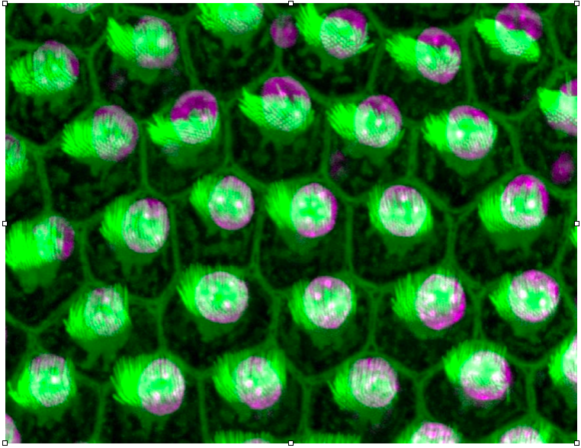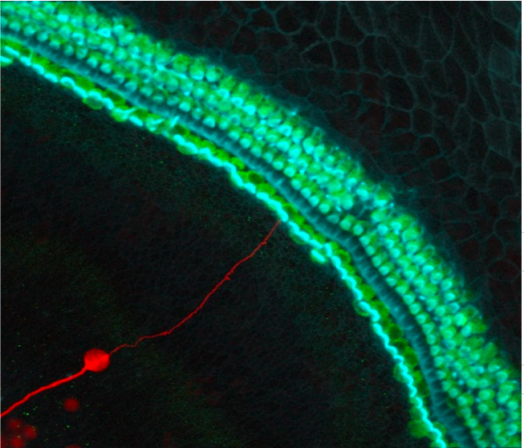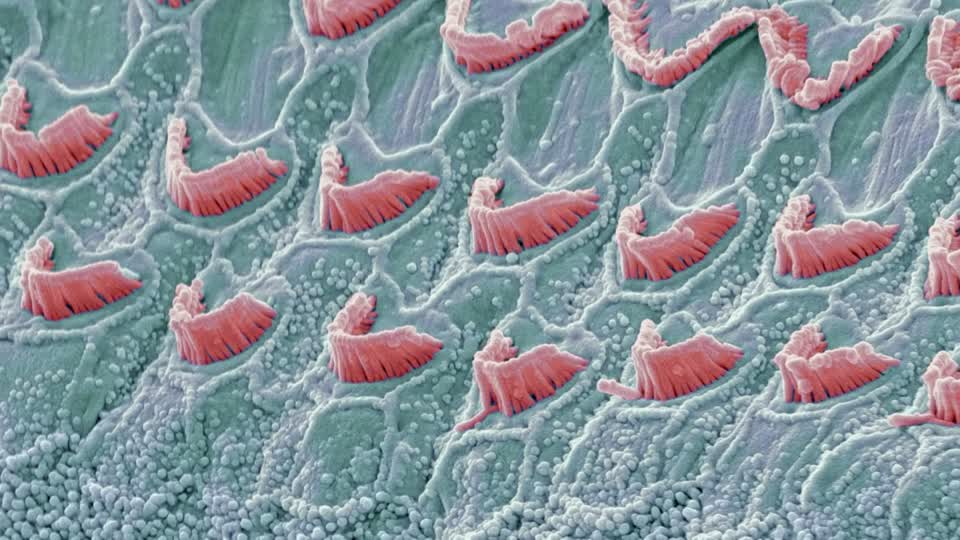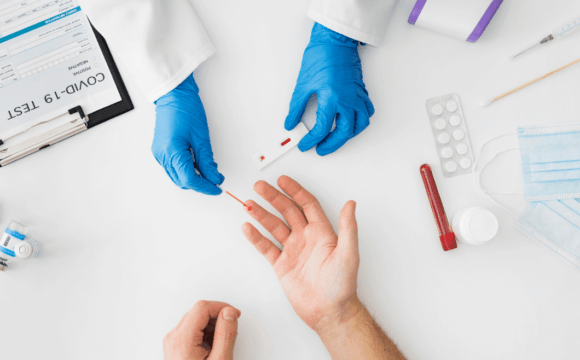Hearing loss is a defect which is fairly common in any population with a number of factors that trigger it. Ageing and chronic exposure to loud noises are significant factors that contribute to hearing loss. Other factors may include infections, some medications, heredity or loss of cells required in the hearing process. Loss of spiral ganglion neurons (SGNs) significantly contributes to hearing loss. Ideally the regeneration of these auditory neurons should restore the hearing ability.

Hair cells in a chicken hearing organ – the nucleus is purple and hair bundles are highlighted green (Credit: Kelvin Y. Kwan/Rutgers University-New Brunswick)
In a recent study, scientists at the Rutgers University–New Brunswick, have discovered that inner ear stem cells can be transformed into auditory neurons which could reverse deafness, however the process can also make these cells divide very quickly, displaying a cancer risk. The study has been published in the scientific journal, Stem Cell Reports.
Hearing loss from over-exposure to noise causes loss of hair cells as well as severe injury to neuronal processes as well as the slow degeneration of auditory neurons. These neurons are forever lost since they do not regenerate once lost. In this study, the researchers over expressed a gene called NEUROG1 to convert inner ear stem cells into auditory neurons. NEUROG1 influences the neural development in both the peripheral nervous system and the central nervous system. In addition to development of SGN, NEUROG1 also affect hair cell development. The researchers could control the conversion of stem cells into auditory neurons in a cell culture dish. They discovered that chromatin (which is DNA wrapped around histone proteins) impacts the function of NEUROG1. Changes in this chromatin might help reduce undesirable stem cell proliferation and one method of achieving this was the addition of drugs to experimental cultures in Petri dishes.

A stem cell-derived neuron grafted onto a mouse cochlea in the inner ear that lacked neurons – the new neuron is marked red, hair cells that convert sounds into neural signals are green and hair bundles are blue
“It’s a cautionary tale,” says Kelvin Kwan, one of the senior authors in the study. “People usually say, ‘we’ll add stem cells to a system and replace lost neurons.’ We agree that ‘yes, we can grow neurons,’ however, there are other side effects which are unexpected, such as increased proliferation of stem cells.” He has also warned that since NEUROG1 is used in various stem cell experiments to grow different types of neurons, scientists in other fields should be alert, that by using this factor, they are likely to also increase cell proliferation and hence, cancer.
“Ideally, we would change the chromatin state before we start over expressing NEUROG1 and prevent unwanted stem cell proliferation,” suggests Kwan.
(Perform cell culture experiments efficiently with our products [https://www.biomall.in/category/cell-culture-dishes])
This study is a reminder as to how various treatments, including such stem cell therapies, require further improvement to remove adverse side effects. While controlling the extra cell proliferation in culture dishes is a good start, the same needs to be replicated in the patient. Nevertheless, this therapy has great potential in regenerating the lost hearing ability. The researchers have much more to rectify in this treatment before testing it in clinical trials.
References:
Song, Z., Jadali, A., Fritzsch, B., & Kwan, K. Y. (2017). NEUROG1 Regulates CDK2 to Promote Proliferation in Otic Progenitors. Stem Cell Reports, 9(5), 1516-1529.
https://newatlas.com/stem-cell-hearing-cancer-risk/52108/









